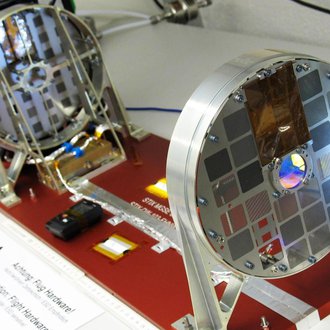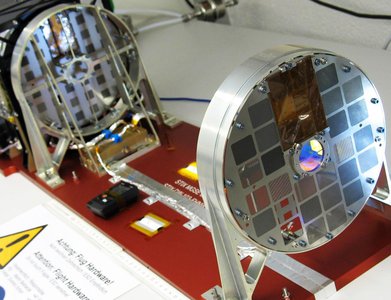X-Ray Telescope STIX Ready for Launch to the Sun

The imager of the telescope STIX, which filters the X-ray radiation, and the detector box (black, in background), that measures the X-ray radiation.
Credit: AIP/Hakan ÖnelTo observe the Sun at close range and measure its activity: with launch in February 2019, as part of the European Space Agency’s (ESA) Solar Orbiter spacecraft, STIX will study solar X-ray radiation in unprecedented detail. An international team with researchers from the Leibniz Institute for Astrophysics Potsdam (AIP) has developed STIX and now completed it. The AIP is the only German institute involved in this instrument.
STIX (short for Spectrometer/Telescope for Imaging X-rays) is designed to measure X-ray radiation emitted from the hot corona, the outer solar atmosphere. X-ray radiation is an indicator for magnetic solar activity. STIX consists of windows in the heat shield, the imager and the detector box. X-ray radiation passes through the windows in the heat shield, it is subsequently filtered by the imager unit and finally detected by the detector box – in order to obtain images of the hottest regions of solar eruptions with temperatures of up to 40 million degrees Celsius.
AIP developed the fundamental imager design, machined actual flight parts, and supported the assembly and integration of the instrument. Furthermore, AIP accompanied the test campaign aimed to verify that the instrument can withstand strong vibration levels and large temperature fluctuations. It took about eight years to complete the STIX imager. The German Space Agency (Deutsches Zentrum für Luft- und Raumfahrt, DLR) funded AIP with 1.8 million Euros for this project. Now, the international instrument team led by the Fachhochschule Nordwestschweiz (FHNW) has delivered STIX to Airbus Defence and Space (UK), where all instruments will be integrated into the Solar Orbiter spacecraft. Solar Orbiter is equipped with ten instruments to investigate the Sun and its environment.
Scientists hope to find answers to some of the Sun’s yet unanswered questions with STIX data. They will study how solar flares are generated and how they affect the interplanetary space, the Earth’s environment and our technical civilisation. During Solar Orbiter’s ten year mission it will closely approach the Sun to about one quarter of the distance between Sun and Earth. It will even leave the ecliptic plane allowing for observations of the solar poles. Solar Orbiter will collect unprecedented data from perspectives never seen before.
Science contacts:
apl. Prof. Dr. Gottfried Mann (Projektleiter), +49 331-7499 292, gmann@aip.de
Dr. Hakan Önel, +49 331-7499 261, honel@aip.de
Further information
STIX website:
http://www.aip.de/en/research/research-area-cmf/cosmic-magnetic-fields/solar-physics/solar-radio-physics/solo
Images
The imager of the telescope STIX, which filters the X-ray radiation, and the detector box (black, in background), that measures the X-ray radiation.
Big screen size [1000 x 766, 130 KB]
Original size [1733 x 1329, 250 KB]



